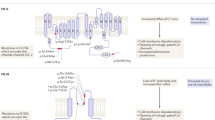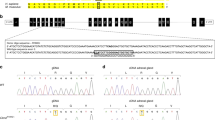Abstract
Glucocorticoid-remediable aldosteronism (GRA) is an autosomal-dominant inherited aldosteronism that is often accompanied by early-onset hypertension. GRA is caused by the unequal crossover of the 11β-hydroxylase (CYP11B1) and aldosterone synthase (CYP11B2) genes. As a result of chimeric gene duplication, aldosterone is ectopically synthesized in the adrenal zona fasciculata under the control of adrenocorticotropic hormone (ACTH). Here, we describe a Chinese pedigree with three affected subjects. Both the uncle and nephew were hospitalized in our hospital due to early-onset hypertension (onset <20 years old) and were diagnosed with primary aldosteronism (PA). Their laboratory test results revealed hyperaldosteronism, hyporeninemia, a high plasma aldosterone to renin (ARR) ratio, and normal serum potassium (K+). Captopril failed to suppress aldosterone secretion. This family had a strong paternal history of hypertension. Thirteen members underwent gene testing, and three of them were found to be GRA positive. Through long-extension PCR (XL-PCR) and direct sequencing, we identified the CYP11B1/CYP11B2 chimeric gene, and with unequal crossover breakpoints located between intron 2 of CYP11B1 and exon 3 of CYP11B2 in the three patients. Low-dose dexamethasone was effective. This is the first family report of GRA in northern China. Moreover, a case of GRA combined with a CACNA1H gene mutation is reported for the first time. We found that dihydropyridine calcium channel blockers (CCBs) combined with aldosterone receptor antagonists exerted good therapeutic effects in controlling blood pressure in GRA patients for whom glucocorticoid therapy was not an option.
This is a preview of subscription content, access via your institution
Access options
Subscribe to this journal
Receive 12 print issues and online access
$259.00 per year
only $21.58 per issue
Buy this article
- Purchase on Springer Link
- Instant access to full article PDF
Prices may be subject to local taxes which are calculated during checkout



Similar content being viewed by others
References
Pizzolo F, Trabetti E, Guarini P, Mulatero P, Ciacciarelli A, Blengio GS, et al. Glucocorticoid remediable aldosteronism (GRA) screening in hypertensive patients from a primary care setting. J Hum Hypertens. 2005;19:325–327.
Sutherland DJ, Ruse JL, Laidlaw JC. Hypertension, increased aldosterone secretion and low plasma renin activity relieved by dexamethasone. Can Med Assoc J. 1966;95:1109–1119.
Litchfield WR, Anderson BF, Weiss RJ, Lifton RP, Dluhy RG. Intracranial aneurysm and hemorrhagic stroke in glucocorticoid-remediable aldosteronism. Hypertension 1998;31:445–450. 1 Pt 2
Lifton RP, Dluhy RG, Powers M, Rich GM, Gutkin M, Fallo F, et al. Hereditary hypertension caused by chimaeric gene duplications and ectopic expression of aldosterone synthase. Nat Genet. 1992;2:66–74.
Jonsson JR, Klemm SA, Tunny TJ, Stowasser M, Gordon RD. A new genetic test for familial hyperaldosteronism type I aids in the detection of curable hypertension. Biochem Biophys Res Commun. 1995;207:565–571.
MacConnachie AA, Kelly KF, McNamara A, Loughlin S, Gates LJ, Inglis GC, et al. Rapid diagnosis and identification of cross-over sites in patients with glucocorticoid remediable aldosteronism. J Clin Endocrinol Metab. 1998;83:4328–4331.
Carvajal CA, Stehr CB, González PA, Riquelme EM, Montero T, Santos MJ, et al. A de novo unequal cross-over mutation between CYP11B1 and CYP11B2 genes causes familial hyperaldosteronism type I. J Endocrinol Investig. 2011;34:140–144.
Myers S, Freeman C, Auton A, Donnelly P, McVean G. A common sequence motif associated with recombination hot spots and genome instability in humans. Nat Genet. 2008;40:1124–1129.
Seidel E, Schewe J, Scholl UI. Genetic causes of primary aldosteronism. Exp Mol Med. 2019;51:1–12.
Dluhy RG, Anderson B, Harlin B, Ingelfinger J, Lifton R. Glucocorticoid-remediable aldosteronism is associated with severe hypertension in early childhood. J Pediatr. 2001;138:715–720.
Mulatero P, di Cella SM, Williams TA, Milan A, Mengozzi G, Chiandussi L, et al. Glucocorticoid remediable aldosteronism: low morbidity and mortality in a four-generation Italian pedigree. J Clin Endocrinol Metab. 2002;87:3187–3191.
Dluhy RG, Lifton RP. Glucocorticoid-remediable aldosteronism (GRA): diagnosis, variability of phenotype and regulation of potassium homeostasis. Steroids. 1995;60:48–51.
Jamieson A, Slutsker L, Inglis GC, Fraser R, White PC, Connell JM. Glucocorticoid-suppressible hyperaldosteronism: effects of crossover site and parental origin of chimaeric gene on phenotypic expression. Clin Sci. 1995;88:563–570.
Rich GM, Ulick S, Cook S, Wang JZ, Lifton RP, Dluhy RG. Glucocorticoid-remediable aldosteronism in a large kindred: clinical spectrum and diagnosis using a characteristic biochemical phenotype. Ann Intern Med. 1992;116:813–820.
Mulatero P, Veglio F, Pilon C, Rabbia F, Zocchi C, Limone P, et al. Diagnosis of glucocorticoid-remediable aldosteronism in primary aldosteronism: aldosterone response to dexamethasone and long polymerase chain reaction for chimeric gene. J Clin Endocrinol Metab. 1998;83:2573–2575.
McMahon GT, Dluhy RG. Glucocorticoid-remediable aldosteronism. Cardiol Rev. 2004;12:44–48.
Litchfield WR, New MI, Coolidge C, Lifton RP, Dluhy RG. Evaluation of the dexamethasone suppression test for the diagnosis of glucocorticoid-remediable aldosteronism. J Clin Endocrinol Metab. 1997;82:3570–3573.
Acknowledgements
This work was supported by the National Key R&D Program of China (Project ID.2018YFC1312703 from JC), CAMS Innovation Fund for Medical Sciences (2016-I2 M-1-006 from JC), National Natural Science Foundation of China (Project ID.81630014 and81825002 from JC, Project ID 81700374 from LJ), Beijing Outstanding Young Scientist Program (Project ID.BJJWZYJH01201910023029, from JC) and the Fundamental Research Funds for the Central Universities (Project ID.3332018055, from XL).
Author information
Authors and Affiliations
Corresponding author
Ethics declarations
Conflict of interest
The authors declare no competing interests.
Additional information
Publisher’s note Springer Nature remains neutral with regard to jurisdictional claims in published maps and institutional affiliations.
Rights and permissions
About this article
Cite this article
Liu, X., Jin, L., Zhang, H. et al. A Chinese pedigree with glucocorticoid remediable aldosteronism. Hypertens Res 44, 1428–1433 (2021). https://doi.org/10.1038/s41440-021-00685-3
Received:
Revised:
Accepted:
Published:
Issue Date:
DOI: https://doi.org/10.1038/s41440-021-00685-3



